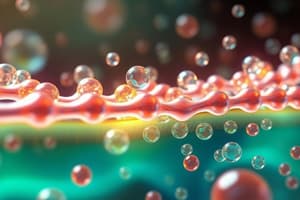Podcast
Questions and Answers
Which of the following statements correctly describes the function of the Na+/K+ ATPase?
Which of the following statements correctly describes the function of the Na+/K+ ATPase?
- Pumps 3 Na⁺ ions out and 2 K⁺ ions in while hydrolyzing 1 ATP. (correct)
- Pumps 2 Na⁺ ions out and 3 K⁺ ions in without using ATP.
- Pumps 2 Na⁺ ions out and 3 K⁺ ions in while hydrolyzing 1 ATP.
- Pumps 3 Na⁺ ions out and 2 K⁺ ions in while synthesizing 1 ATP.
Aquaporins facilitate the active transport of water molecules across the cell membrane, requiring energy in the form of ATP.
Aquaporins facilitate the active transport of water molecules across the cell membrane, requiring energy in the form of ATP.
False (B)
Briefly explain the 'ball-and-chain' model as it relates to the function of voltage-gated ion channels.
Briefly explain the 'ball-and-chain' model as it relates to the function of voltage-gated ion channels.
The 'ball-and-chain' model elucidates a mechanism for channel inactivation, where a portion of the channel protein (the 'ball') physically blocks the channel pore after a certain period of activation, thus halting ion flow.
__________ is the technique used to measure ion channel activity in cells by recording electrical currents.
__________ is the technique used to measure ion channel activity in cells by recording electrical currents.
Match the type of glutamate receptor with its structure and a defining characteristic:
Match the type of glutamate receptor with its structure and a defining characteristic:
Which characteristic of unsaturated fatty acids contributes to their lower melting points compared to saturated fatty acids?
Which characteristic of unsaturated fatty acids contributes to their lower melting points compared to saturated fatty acids?
Cholesterol decreases membrane fluidity at both high and low temperatures.
Cholesterol decreases membrane fluidity at both high and low temperatures.
What is the primary function of brown adipose tissue (BAT), and which protein is essential for this function?
What is the primary function of brown adipose tissue (BAT), and which protein is essential for this function?
During periods of fasting or low carbohydrate intake, the liver produces ______ as an alternative fuel source for the brain.
During periods of fasting or low carbohydrate intake, the liver produces ______ as an alternative fuel source for the brain.
Match the following lipids with their primary function or location:
Match the following lipids with their primary function or location:
In fatty acid synthesis, what is the key regulatory step involving Acetyl-CoA in the cytosol?
In fatty acid synthesis, what is the key regulatory step involving Acetyl-CoA in the cytosol?
What is the primary purpose of β-oxidation?
What is the primary purpose of β-oxidation?
Which of these is a ligand-gated ion channel?
Which of these is a ligand-gated ion channel?
Flashcards
Ionotropic Glutamate Receptors (iGluRs)
Ionotropic Glutamate Receptors (iGluRs)
Receptors activated by glutamate that allow ions to flow, important for fast synaptic transmission. Tetrameric structure.
Voltage-Gated Ion Channels
Voltage-Gated Ion Channels
Proteins that open or close based on changes in the electrical potential across the cell membrane.
Active Transport
Active Transport
Transport across a membrane that requires energy input, such as ATP hydrolysis.
Na+/K+ ATPase
Na+/K+ ATPase
Signup and view all the flashcards
GABA Transporters (GAT)
GABA Transporters (GAT)
Signup and view all the flashcards
Amphipathic Lipids
Amphipathic Lipids
Signup and view all the flashcards
Saturated Fatty Acids
Saturated Fatty Acids
Signup and view all the flashcards
Unsaturated Fatty Acids
Unsaturated Fatty Acids
Signup and view all the flashcards
Cholesterol's Role in Membranes
Cholesterol's Role in Membranes
Signup and view all the flashcards
Adipose Tissue
Adipose Tissue
Signup and view all the flashcards
Coenzyme Q10 (Ubiquinone)
Coenzyme Q10 (Ubiquinone)
Signup and view all the flashcards
Acetyl-CoA
Acetyl-CoA
Signup and view all the flashcards
Ligand-Gated Ion Channels
Ligand-Gated Ion Channels
Signup and view all the flashcards
Study Notes
- Lipids are hydrophobic, amphipathic molecules with hydrophobic tails and hydrophilic heads.
Major Types of Lipids
- Fatty acids can be saturated, meaning they have no double bonds, or unsaturated, meaning they have one or more double bonds.
- Triglycerides are used for energy storage and are called oils in plants and fats in animals.
- Phospholipids are key components of membrane structure, including glycerophospholipids and sphingolipids.
- Steroids, such as cholesterol, affect membrane fluidity and are used for hormone synthesis.
- Glycolipids are involved in cell signaling and recognition.
Fatty Acids
- Saturated fatty acids pack tightly and have higher melting points.
- Unsaturated fatty acids have kinks due to cis double bonds, resulting in lower melting points.
- Essential fatty acids include Omega-3 (α-linolenic acid) and Omega-6 (linoleic acid).
Membrane Structure and Fluidity
- The fluid mosaic model describes the dynamic movement of lipids and proteins laterally within the membrane.
- Membranes are typically 60-100 Å thick, with a hydrophobic core of about 30 Å.
- Cholesterol increases membrane fluidity at low temperatures and decreases it at high temperatures.
Membrane Asymmetry
- The outer leaflet of the cell membrane mainly contains Phosphatidylcholine (PC) and Sphingomyelin (SM).
- The inner leaflet mainly contains Phosphatidylethanolamine (PE), Phosphatidylserine (PS), and Phosphatidylinositol (PI).
Lipid Functions Beyond Membranes
- White adipose tissue (WAT) stores energy.
- Brown adipose tissue (BAT) produces heat (thermogenesis) using uncoupling protein 1 (UCP1).
Other Roles of Lipids
- Coenzyme Q10 (Ubiquinone) acts as an electron carrier in the mitochondrial electron transport chain.
- Lipid pigments like carotenoids (e.g., canthaxanthin) provide color.
- Eicosanoids (from arachidonic acid) and jasmonate (in plants) function as lipid signaling molecules.
Lipid Metabolism
- Acetyl-CoA serves as a central metabolic intermediate.
- Fatty acid synthesis occurs in the cytosol, converting Acetyl-CoA to Malonyl-CoA and then to fatty acids.
- Cholesterol synthesis also occurs in the cytosol, converting Acetyl-CoA to HMG-CoA, then to Mevalonate, and finally to Cholesterol.
- Ketone bodies are synthesized in the liver mitochondria, converting Acetyl-CoA to Acetoacetate, β-Hydroxybutyrate, and Acetone.
Fatty Acid Oxidation (β-Oxidation)
- Occurs in mitochondria.
- Generates Acetyl-CoA, NADH, and FADH2, which lead to ATP production via the TCA cycle and ETC.
Ketone Bodies
- Produced during fasting or when carbohydrate intake is low.
- The brain uses ketone bodies as fuel when glucose levels are low.
Ion Channels and Membrane Potential
- Ligand-gated ion channels open upon neurotransmitter binding.
- Examples include the Cys-loop family (AchR, GABA, Glycine, 5-HT₃) and ionotropic Glutamate Receptors (iGluRs) like AMPA, NMDA, and Kainate, which have a tetrameric structure.
- The AchR pore diameter is approximately 6.5 Å, allowing Na⁺ and K⁺ to flow through.
Voltage-Gated Ion Channels
- Open in response to changes in membrane potential.
- Examples: Na⁺, K⁺, and Ca²⁺ channels
- Selectivity filters determine ion specificity; for example, the K⁺ channel is 4 Å, and the Na⁺ channel favors Na⁺ based on size.
- The ball-and-chain model describes the mechanism of channel inactivation.
- The resting membrane potential is about -70 mV.
- Action potentials propagate at a speed of around 100 m/s.
Patch-Clamp Technique
- Measures ion channel activity in cells, either in whole-cell or single-channel configurations.
Membrane Transporters
- Passive transport does not require energy and is driven by concentration gradients.
- Active transport requires ATP or ion gradients.
- Primary active transport uses ATP hydrolysis, like the Na+/K+ ATPase.
- Secondary active transport uses ion gradients, like the Na+/Glucose Symporter.
Key Transporters
- The Na+/K+ ATPase (P-Type ATPase) pumps 3 Na⁺ out and 2 K⁺ in while hydrolyzing 1 ATP. This maintains the electrochemical gradient, resting potential, cell volume, and supports secondary transport. It follows the E1-E2 cycle of conformational states during transport and consumes 70-80% of ATP in neurons.
- Calcium ATPase (SERCA) pumps Ca²⁺ into the sarcoplasmic reticulum after muscle contraction.
- The Na+/Ca²⁺ Exchanger (NCX) exchanges 1 Ca²⁺ out for 3 Na⁺ in, and the direction is reversible based on the ion gradients.
- Aquaporins are water channels that facilitate passive osmosis and can transport approximately 3 × 10⁹ water molecules per second per subunit.
- Solute Carrier Transporters (SLCs) include GABA Transporters (GAT), which are Na⁺/Cl⁻ dependent, and Excitatory Amino Acid Transporters (EAATs), which remove glutamate from the synapse to prevent excitotoxicity.
Studying That Suits You
Use AI to generate personalized quizzes and flashcards to suit your learning preferences.




